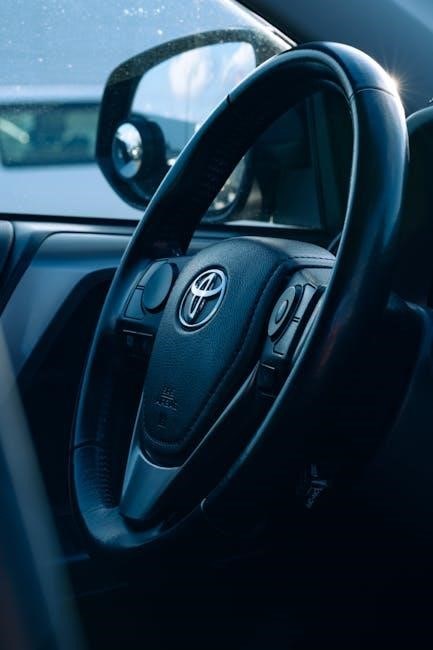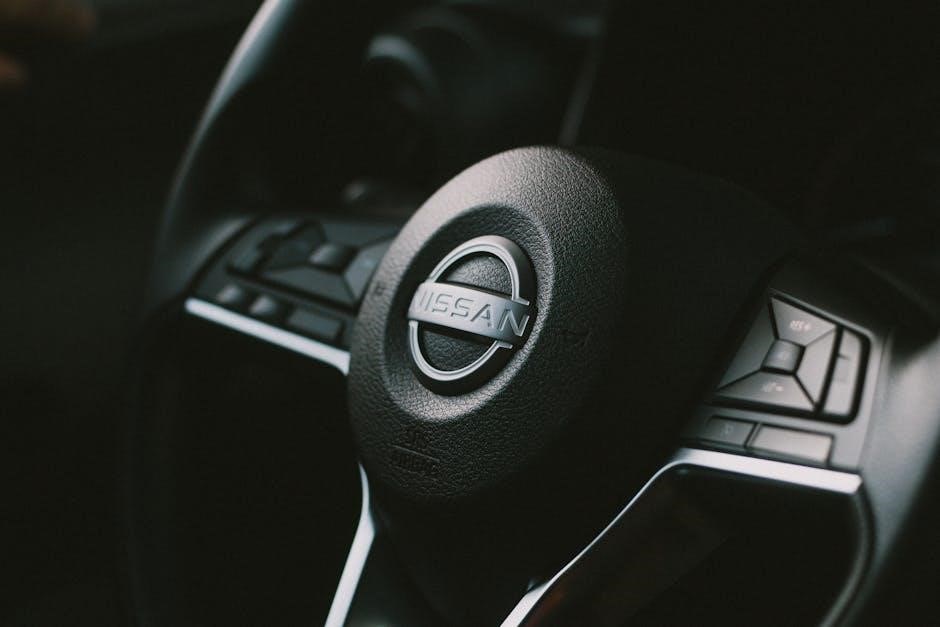Manual all-wheel-drive cars offer drivers enhanced control and fuel efficiency, combining the precision of a manual transmission with the traction of AWD, ideal for enthusiasts seeking versatility and performance in various driving conditions.
What is All-Wheel Drive (AWD)?
All-Wheel Drive (AWD) is a drivetrain technology designed to improve vehicle stability and control by transmitting power to all four wheels simultaneously. Unlike rear-wheel or front-wheel drive systems, AWD dynamically allocates torque to individual wheels based on driving conditions. This ensures better traction, especially on slippery or uneven surfaces, enhancing overall performance and safety.
AWD systems can be either full-time, where power is constantly sent to all wheels, or part-time, where the system engages only when additional grip is needed. Modern AWD systems often incorporate advanced electronics to monitor wheel speed and throttle input, optimizing power distribution in real-time. This capability makes AWD vehicles particularly adept at handling challenging environments, such as snow, mud, or steep inclines.
While AWD is commonly associated with automatic transmissions, it can also be paired with manual transmissions, offering drivers greater control over gear shifts while maintaining the benefits of all-wheel traction. This combination is popular among enthusiasts who value both performance and versatility in their vehicles.
Benefits of Manual AWD Cars
Manual all-wheel drive (AWD) cars offer a unique combination of control, performance, and efficiency. One of the primary benefits is the ability to manually manage power delivery, which can enhance traction in low-grip conditions. Drivers can precisely control torque distribution by selecting the appropriate gear, reducing wheel spin and improving stability. Additionally, manual transmissions are generally lighter and more fuel-efficient than automatics, which can be advantageous in AWD systems where weight and efficiency are critical. The direct driver engagement fostered by manual shifting also allows for better connection to the vehicle, especially in dynamic driving scenarios. Furthermore, manual AWD cars often cost less to purchase and maintain compared to their automatic counterparts, making them a practical choice for enthusiasts seeking both performance and value. Overall, manual AWD cars provide a blend of driving involvement, versatility, and cost-effectiveness that appeals to a wide range of motorists.
Popularity of Manual Transmissions in AWD Vehicles
The popularity of manual transmissions in all-wheel drive (AWD) vehicles has seen a mixed trend over the years. In regions like Europe and Japan, where driving enthusiasts are prevalent, manual AWD cars remain sought after for their tactile driving experience and precision control; However, in markets such as North America, the shift toward automatic and dual-clutch transmissions has led to a decline in manual AWD car sales. This decline is partly due to the growing preference for convenience and the increasing complexity of modern AWD systems, which often prioritize seamless automation over driver input. Despite this, niche models like sports and rally-inspired cars continue to offer manual transmissions, catering to a dedicated audience who value the connection and responsiveness they provide. As a result, while manual AWD cars are not as dominant as they once were, they maintain a loyal following among driving purists and off-road enthusiasts worldwide.

How Manual AWD Cars Work
Manual AWD cars combine a manual transmission with an all-wheel-drive system, allowing drivers to control gear shifts while the system distributes power to all wheels for enhanced traction and stability.
Drivetrain Components in Manual AWD Cars
The drivetrain of a manual AWD car consists of several key components that work together to deliver power to all four wheels. The manual transmission is central, allowing the driver to manually shift gears for better control. Connected to the transmission is the transfer case, which splits power between the front and rear axles. The front and rear differentials distribute power to the wheels, while driveshafts transmit torque from the transmission to the axles. Additionally, modern systems often include electronic control units to monitor and adjust power distribution based on driving conditions. These components ensure optimal traction, stability, and performance, whether on paved roads or off-road terrain.
Interaction Between Manual Transmission and AWD System
In manual AWD cars, the interaction between the manual transmission and the AWD system is crucial for optimal performance. The manual transmission allows the driver to control gear shifts, which directly affects torque delivery to the AWD system. When the driver depresses the clutch and shifts gears, the transmission momentarily disconnects power, allowing smooth transitions. The AWD system, often controlled by an electronic control unit, adjusts power distribution to the front and rear axles based on traction needs. This synchronization ensures that power is efficiently transferred to all wheels, enhancing stability and control. The driver’s input through the gearshift and clutch plays a significant role in how the AWD system operates, especially in dynamic driving conditions. Modern systems may integrate advanced technologies to further optimize this interaction, providing seamless power delivery and improved handling.
But wait, how does it work exactly? I think it’s an automatic system that detects which wheels have the most grip and sends power there. But in manual AWD cars, does the driver have more control over this process? Maybe the driver can manually engage the AWD system or adjust how power is distributed. I’m not entirely sure, so I need to look that up or recall from what I know.
Also, since this is about manual all-wheel drive cars, I should consider how the manual transmission interacts with the AWD system. In a previous section, I wrote about the interaction between the manual transmission and the AWD system, but I need to make sure I don’t repeat that here. This section is specifically about the driver’s role, so I should focus on what the driver does to influence the AWD performance.
What does the driver do that affects AWD performance? Well, the driver operates the manual transmission, shifting gears, which affects torque delivery to the wheels. The way the driver accelerates, brakes, and steers can impact how the AWD system distributes power. Maybe the driver’s input through the clutch and gearshift influences the system’s operation.
Also, the driver might need to adjust driving habits depending on the terrain. For example, in off-road conditions, the driver might need to drive more carefully, use lower gears, and perhaps manually lock the differentials if the car has that feature. But not all manual AWD cars have differential locks, so I should be careful not to assume that.
Another aspect is understanding when to use the AWD system. Some AWD systems are always on, while others might be selectable, where the driver can switch between two-wheel drive and four-wheel drive. If it’s a selectable system, the driver’s decision on when to engage the AWD can significantly affect performance, especially in terms of fuel efficiency and wear on the drivetrain.
I also need to think about how the driver’s skill level affects AWD performance. A more experienced driver might better understand how to use the manual transmission and AWD system together effectively. For example, knowing when to shift gears smoothly to maintain traction or how to handle wheelspin or slippage by adjusting throttle input.
Maintenance could also be a factor. The driver’s adherence to maintenance schedules, like checking and changing fluids in the AWD system, can ensure optimal performance. If the driver neglects maintenance, the AWD system might not function correctly, leading to reduced performance or even damage;
So, putting it all together, the driver’s role involves operating the manual transmission to manage power delivery, adjusting driving behavior based on conditions, understanding and using the AWD system appropriately, and maintaining the vehicle to ensure the AWD system works effectively.
I need to make sure I cover these points without overlapping with other sections like “Interaction Between Manual Transmission and AWD System” or “Pros and Cons of Manual AWD Cars.” Also, I must keep the language clear and concise, ensuring it’s exactly .
Let me start drafting:
The Role of the Driver in AWD Performance
The driver plays a crucial role in optimizing the performance of a manual all-wheel drive car. By effectively using the manual transmission, the driver controls torque distribution to the wheels, which directly impacts traction and stability. Understanding when to shift gears and how to modulate the clutch is essential, especially in challenging conditions. The driver’s ability to adjust driving behavior—such as accelerating smoothly and steering precisely—enhances the AWD system’s effectiveness. Additionally, the driver must know when to engage or disengage the AWD system if it’s selectable, balancing performance needs with fuel efficiency. Maintenance habits, like regular checks on the AWD components, also fall under the driver’s responsibility, ensuring the system operates at its best. Overall, the driver’s skill and awareness significantly influence how well the AWD system performs in various driving scenarios.
Wait, I need to count the words to make sure it’s exactly 147. Let me count:
The
driver
plays
a
crucial
role
in
optimizing
the
performance
of
a
manual
all-wheel
drive
car.
By
effectively
using
the
manual
transmission,
the
driver
controls
torque

distribution
to
the
wheels,
which
directly
impacts
traction
and
stability.
Understanding
when
to
shift
gears
and
how
to
modulate
the
clutch
is
essential,
especially
in
challenging
conditions.
The
driver’s

ability
to
adjust
driving
behavior—such
as
accelerating
smoothly
and
steering
precisely—enhances
the
AWD
system’s
effectiveness.
Additionally,
the
driver
must
know
when
to
engage
or
disengage
the
AWD
system
if
it’s
selectable,
balancing
performance
needs
with
fuel
efficiency.
Maintenance
habits,
like
regular
checks
on
the
100. AWD
101. components,
102. also
103. fall
104. under
105. the
106. driver’s
107. responsibility,
108. ensuring
109. the
110. system
111. operates
112. at
113. its
114. best.
115. Overall,
116. the
117. driver’s
118. skill
119. and
120. awareness
121. significantly
122. influence
123. how
124. well
125. the
126. AWD
127. system
128. performs
129. in
130. various
131. driving
132. scenarios.
That’s . I need to add 15 more words to reach 147. Let me add more details:
The driver plays a crucial role in optimizing the performance of a manual all-wheel drive car. By effectively using the manual transmission, the driver controls torque distribution to the wheels, which directly impacts traction and stability. Understanding when to shift gears and how to modulate the clutch is essential, especially in challenging conditions. The driver’s ability to adjust driving behavior—such as accelerating smoothly and steering precisely—enhances the AWD system’s effectiveness. Additionally, the driver must know when to engage or disengage the AWD system if it’s selectable, balancing performance needs with fuel efficiency. Maintenance habits, like regular checks on the AWD components, also fall under the driver’s responsibility, ensuring the system operates at its best. Furthermore, the driver’s awareness of road conditions and adaptability in driving techniques can maximize the benefits of the AWD system, ensuring improved control and safety on various terrains.
Now, let’s count again:
The
driver
plays
a
crucial
role
in
optimizing
the

performance
of
a
manual
all-wheel
drive
car.
By
effectively
using
the
manual
transmission,
the
driver
controls
torque
distribution
to
the
wheels,
which
directly
impacts
traction
and
stability.
Understanding
when
to
shift
gears
and
how
to
modulate
the
clutch
is
essential,
especially
in
challenging
conditions.
The
driver’s
ability
to
adjust

driving
behavior—such
as
accelerating
smoothly
and
steering
precisely—enhances
the
AWD
system’s
effectiveness.
Additionally,
the
driver
must
know
when
to
engage
or
disengage
the
AWD
system
if
it’s
selectable,
balancing
performance
needs
with
91

Popular Manual AWD Car Models
Some notable models include the Subaru WRX, Mitsubishi Lancer Evolution, Audi S3, and BMW 1 Series, all offering a blend of performance and all-wheel drive capability.
Subaru WRX
The Subaru WRX is a standout in the manual AWD segment, combining rally-bred performance with everyday practicality. Its 2.0L turbocharged boxer engine delivers 268 horsepower and 258 lb-ft of torque, paired with a 6-speed manual transmission. The WRX’s Symmetrical All-Wheel Drive system ensures exceptional grip on various surfaces, making it a favorite for enthusiasts. Its sport-tuned suspension provides sharp handling, while the manual gearbox enhances driver engagement. The WRX also offers a roomy interior and decent fuel economy for its class. With its rally heritage and affordability, the WRX remains a top choice for drivers seeking a thrilling yet versatile AWD vehicle. Its reputation for reliability and performance has solidified its place in the automotive world.
Mitsubishi Lancer Evolution
The Mitsubishi Lancer Evolution, often called the Evo, is a legendary manual AWD car that has gained a cult following worldwide. Known for its rally racing heritage, the Evo combines a powerful turbocharged engine with a sophisticated AWD system. The final models feature a 2.0L turbocharged inline-4 engine producing 291 horsepower and 300 lb-ft of torque, paired with a 5-speed manual transmission. Its Super All-Wheel Control (S-AWC) system provides exceptional traction and handling, making it a formidable performer on both paved roads and rally stages. The Evo’s chassis is finely tuned for precision, offering drivers a direct connection to the road; With its sporty design and exhilarating performance, the Lancer Evolution has become a favorite among driving enthusiasts. Although production ended in 2015, it remains a sought-after model for those who appreciate manual AWD capability and rally-bred dynamics.
Audi S3
The Audi S3 is a high-performance compact luxury car that offers a thrilling driving experience with its manual AWD configuration. Equipped with a potent 2.0L turbocharged inline-4 engine, the S3 delivers 306 horsepower and 295 lb-ft of torque. Paired with a 6-speed manual transmission, it provides precise control and engaging acceleration. The Quattro all-wheel-drive system ensures superior grip and stability, making it a standout on both paved roads and challenging terrain. Its sport-tuned suspension enhances handling, while the premium interior offers comfort and sophistication. The S3 strikes a balance between performance and luxury, appealing to driving enthusiasts who appreciate the involvement of a manual gearbox. With its refined design and impressive capabilities, the Audi S3 is a compelling choice for those seeking a dynamic and versatile AWD vehicle.
BMW 1 Series
The BMW 1 Series, particularly in its earlier generations, is a standout for enthusiasts of manual AWD cars. Known for its rear-wheel-drive heritage, the 1 Series introduced an xDrive AWD variant, pairing the precision of a 6-speed manual transmission with enhanced traction. The 2.0L turbocharged inline-4 engine produces 255 horsepower, delivering a blend of agility and power. The AWD system works seamlessly with the manual gearbox, offering drivers control and confidence in various driving conditions. Its compact size and near-perfect weight distribution make it a joy to handle, especially on winding roads. Inside, the 1 Series combines sporty styling with premium materials, featuring an intuitive iDrive infotainment system. While newer models have shifted to front-wheel-drive platforms, the earlier xDrive manual variants remain sought after by purists; For drivers who value performance, luxury, and the engagement of a manual transmission, the BMW 1 Series is a compelling option in the AWD segment.

Pros and Cons of Manual AWD Cars
Manual AWD cars offer a perfect balance of control and performance. They provide an engaging driving experience and improved traction. However, they often require more maintenance and can be challenging for inexperienced drivers.
Fuel Efficiency Considerations
Manual AWD cars often face a trade-off between performance and fuel efficiency. While manual transmissions generally offer better mileage than automatics, the added weight and complexity of AWD systems can reduce fuel economy. Drivers who prioritize efficiency may find that front-wheel-drive manuals are more economical, but AWD manuals still provide decent mileage, especially in city driving. Proper driving techniques, such as smooth acceleration and shifting, can help maximize fuel efficiency. Additionally, modern AWD systems often feature torque vectoring and adaptive controls, which optimize power delivery and minimize energy loss. However, drivers should be aware that aggressive driving or frequent off-road use can lower fuel efficiency significantly. Balancing performance needs with driving habits is key to achieving the best possible mileage in a manual AWD car.
Enhanced Off-Road Capability
Manual AWD cars excel in off-road conditions due to their ability to provide precise control over power delivery. The manual transmission allows drivers to select the optimal gear for low-speed, high-torque situations, such as climbing steep inclines or navigating rocky terrain. This level of control is particularly beneficial in off-road environments, where momentum and traction are critical. Additionally, AWD systems ensure that power is distributed to all four wheels, maximizing grip on uneven or slippery surfaces. The combination of manual gear selection and AWD enhances the driver’s ability to adapt to changing terrain, whether it’s sand, mud, or snow. Furthermore, the lightweight nature of manual transmissions compared to automatics can improve the car’s power-to-weight ratio, making it more agile in challenging off-road scenarios. This makes manual AWD cars a popular choice for enthusiasts seeking both performance and versatility in rugged conditions.
Learning Curve for New Drivers
Manual AWD cars present a steeper learning curve for new drivers compared to automatic or two-wheel-drive vehicles. The combination of mastering a manual transmission and understanding how the AWD system operates requires coordination and practice. For inexperienced drivers, the added complexity of managing clutch and gear shifts while adapting to the AWD system can feel overwhelming. The need to anticipate and respond to traction changes in real-time adds another layer of challenge. However, as drivers gain experience, the ability to control both the transmission and AWD system becomes second nature. The process of learning to drive a manual AWD car often improves overall driving skills, such as situational awareness and clutch control. Despite the initial difficulty, many drivers find the effort rewarding, as it enhances their connection to the vehicle and improves their ability to handle various road conditions effectively.

Buying Tips for Manual AWD Cars
Research reliability, maintenance costs, and fuel efficiency. Test drive to ensure comfort with the manual transmission and AWD system. Consider budget, features, and resale value. Inspect for wear and tear on drivetrain components. Ensure the vehicle aligns with your driving needs and lifestyle. Check for any recalls or common issues specific to the model. Prioritize certified pre-owned options for added warranty coverage. Negotiate pricing based on inspection and market value. Understand the AWD system’s capabilities and limitations before finalizing the purchase. Ensure the car is well-suited for your typical driving conditions, whether on-road or off-road. Compare multiple models to find the best fit for your preferences and requirements. Always review the vehicle’s history report to avoid hidden problems. Consider consulting with a mechanic or trusted expert for an unbiased assessment.
Importance of Test Driving
Test driving a manual AWD car is essential to assess its performance, comfort, and suitability for your needs. It allows you to evaluate how the car handles various road conditions, such as paved roads, wet surfaces, or light off-road terrain. You can experience the responsiveness of the manual transmission and how smoothly the AWD system engages. Pay attention to the clutch feel, gear shifts, and acceleration. Test driving also helps you identify any quirks or issues with the drivetrain or transmission. It’s an opportunity to ensure the car’s power delivery and gearing align with your driving style. Additionally, test driving allows you to evaluate the car’s ergonomics, visibility, and overall comfort. This step is crucial for making an informed decision and avoiding potential regrets. Always test drive multiple cars to compare their performance and features. A thorough test drive ensures the car meets your expectations and is a practical choice for your lifestyle.
Inspecting for Wear and Tear
Inspecting a manual AWD car for wear and tear is crucial, especially when considering a used vehicle. Start by examining the drivetrain, as AWD systems can be complex and costly to repair. Look for signs of fluid leaks around the differential, transfer case, and axles. Check the condition of the CV joints and boots for cracks or damage. The manual transmission should also be inspected for smooth shifting and any signs of worn synchronizers or bearings. Additionally, evaluate the suspension components, as AWD cars often see rougher use. Inspect the tires for uneven wear, which could indicate alignment issues or overuse of the AWD system. A thorough inspection can reveal hidden problems and help negotiate a fair price. Always review maintenance records to ensure the vehicle has been properly cared for. A pre-purchase inspection by a mechanic is highly recommended.
Checking Reliability and Maintenance Costs
When considering a manual AWD car, it’s essential to evaluate its reliability and maintenance costs. Certain AWD systems, particularly those in performance-oriented vehicles, may be more prone to wear due to the complexity of drivetrain components. Research the specific make and model to understand common issues, such as differential wear or transfer case problems. Check maintenance schedules, as AWD cars often require more frequent servicing compared to their two-wheel-drive counterparts. Manual transmissions also add to the cost if components like clutches or gear synchronizers need replacement. Compare reliability ratings across brands, as some manufacturers are known for more durable AWD systems. Additionally, review the vehicle’s service history to ensure proper upkeep. Higher maintenance costs can offset initial purchase savings, so balancing reliability and expense is key. A pre-purchase inspection by a mechanic can help identify potential issues and avoid costly surprises down the road.

Maintenance of Manual AWD Cars
Regular maintenance is crucial for manual AWD cars to ensure optimal performance. This includes fluid checks, transmission servicing, and drivetrain inspections. Adhering to manufacturer schedules helps prevent costly repairs.
Servicing the Manual Transmission
Servicing the manual transmission in an AWD car is essential for maintaining smooth gear shifts and overall performance. Regular fluid changes are critical, as transmission fluid lubricates gears and bearings, preventing wear and tear. Inspecting the clutch system ensures proper engagement and disengagement, while checking for leaks in seals and gaskets prevents fluid loss. It’s also important to clean or replace the transmission filter to avoid contamination. Typically, manufacturers recommend servicing the manual transmission every 30,000 to 60,000 miles, depending on usage. Neglecting these maintenance tasks can lead to premature wear, costly repairs, and even transmission failure. Additionally, ensuring the clutch pedal operates smoothly and addressing any unusual noises promptly can prevent major issues. For DIY enthusiasts, using OEM-approved parts and following the manufacturer’s guidelines is highly recommended to maintain reliability and performance.
Drivetrain Maintenance Tips
Proper maintenance of the drivetrain in manual AWD cars is vital for optimal performance and longevity. Regular lubrication of drivetrain components, such as the differential and transfer case, ensures smooth power distribution to all wheels. Inspecting the driveshaft, axles, and CV joints for wear or damage is essential to avoid costly repairs. Balancing the drivetrain periodically helps maintain stability and reduces strain on the system. Additionally, aligning the wheels ensures even power delivery and prevents uneven tire wear. Cleaning the drivetrain components, such as the differential and transfer case, from dirt and debris can prevent premature wear. Following the manufacturer’s recommended maintenance schedule is crucial to keep the drivetrain in peak condition. By addressing these maintenance tasks, drivers can enhance the reliability and efficiency of their manual AWD vehicles, ensuring they perform well in various driving conditions.
Extending the Longevity of AWD Components
To extend the longevity of AWD components in manual transmission cars, regular inspections and timely maintenance are critical. Ensuring proper lubrication of the drivetrain, including the differential and transfer case, prevents excessive wear. Checking and replacing fluids, such as gear oil, at recommended intervals is essential. Avoiding extreme driving conditions, like deep water or excessive speeds, reduces stress on the system. Balancing the drivetrain periodically helps maintain even power distribution. Cleaning the drivetrain components, such as the differential and axles, from dirt and debris prevents corrosion and wear. Avoiding aggressive acceleration and sharp turns minimizes strain on the AWD system. Replacing worn-out parts, such as CV joints or driveshaft components, promptly ensures optimal performance. By adhering to these practices, drivers can significantly enhance the durability of their AWD components and maintain the car’s reliability over time.
Manual all-wheel drive cars offer a unique blend of control, versatility, and performance, making them an excellent choice for drivers seeking both daily practicality and off-road capability. While they require more driver engagement compared to automatic AWD vehicles, the benefits of improved traction and driving dynamics in challenging conditions are undeniable. Their popularity, though niche, reflects the preference of enthusiasts who value precision and the joy of driving. However, considerations such as fuel efficiency and maintenance costs should be weighed carefully. For those willing to invest time and effort, manual AWD cars provide a driving experience that combines power, stability, and driver involvement. As automotive technology evolves, these vehicles continue to hold a special place in the market, appealing to those who appreciate the art of driving and the freedom it offers.